1.1. Principles of Data-Intensive Systems
CS 245 Principles of Data-Intensive Systems @ Stanford
1.1.1. Intro
In many ways, data systems are the highest-level successful programming abstractions
How to Read a Paper: TLDR: don’t just go through end to end; focus on key ideas/sections
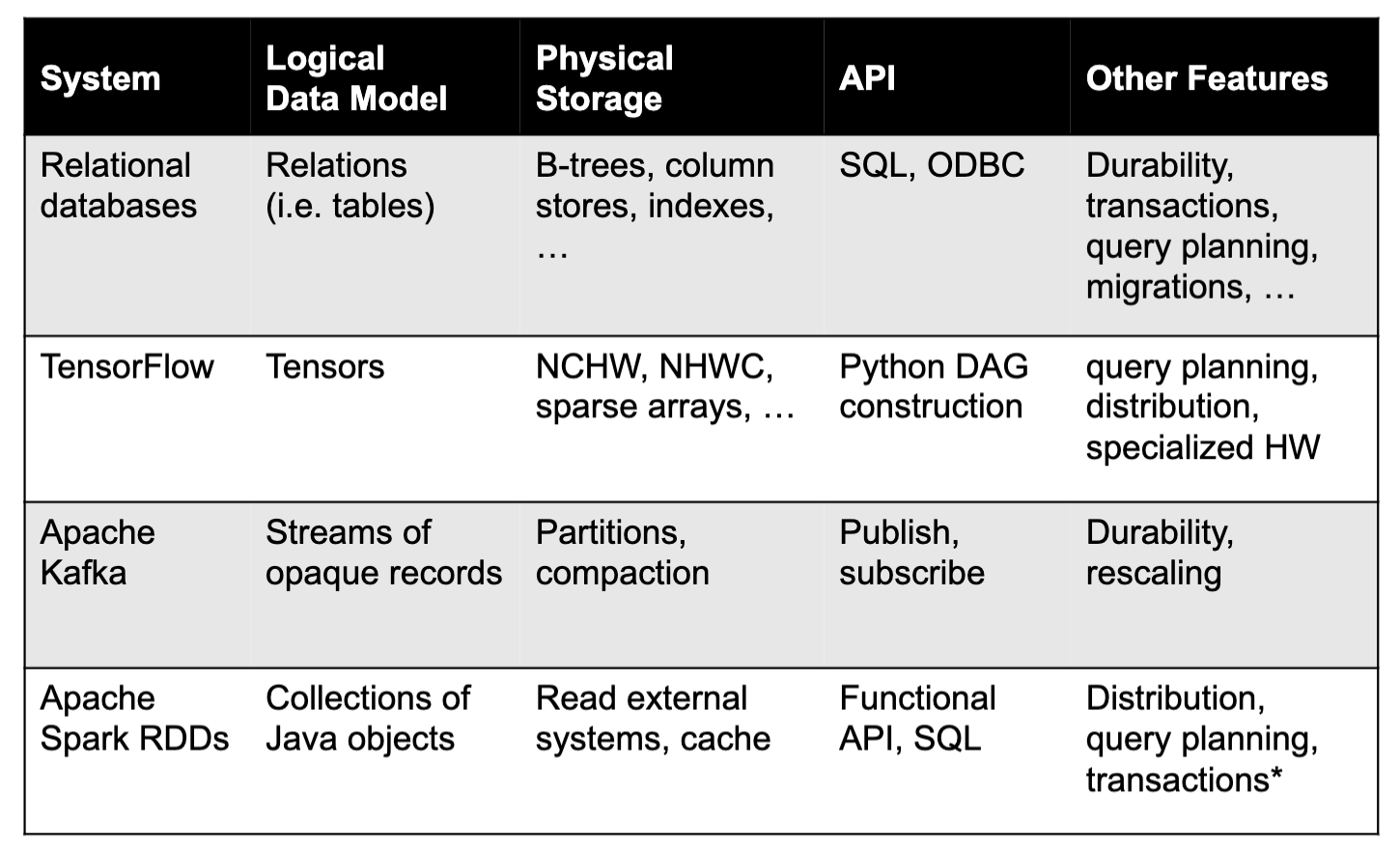
Two big ideas
- Declarative interfaces (declarative APIs)
- apps sepcify what they want, not how to do it
- Example: “store a table with 2 integer columns”, but not how to encode it on disk;
- SQL: Abstract “table” data model, many physical implementations; Specify queries in a restricted language that the database can optimize
- TensorFlow: Operator graph gets mapped & optimized to different hardware devices
- Functional programming (e.g. MapReduce): Says what to run but not how to do scheduling
- Declaration instead of definition in code: make simple high-level abstraction and leave room for low-level optimization
- Transactions
- Compress multiple actions into one atomic request
- SQL db
- Spark, MapReduce: Make the multi-part output of a job appear atomically when all partitions are done
- Stream processing systems: Count each input record exactly once despite crashes, network failures, etc
Rest of the course
- Declarative interfaces
- Data independence and data storage formats
- Query languages and optimization
- Transactions, concurrency & recovery
- Concurrency models
- Failure recovery
- Distributed storage and consistency
1.1.2. Database Archtecture
System R discussion
System R already has essential arch as a modern RDBMS
- SQL, cost-bases optimizer, compiling queries to asm
- many storate & access methods (b-trees), view-based access control
- lock manager, recovery via (write-ahead) logging / shadow pages (expensive for large files) (two for in-place updates)
Handling failures
- disk/storage media failure: main + backup disks
- system crash failure: shadow pages
- txn failure: log + lock
Tradeoff
- Fine-grained locking
- lock records, fields, specific ops (R/W)
- more concurrency, higher runtime overhead
- Coarse-grained locking
- lock whole table for broader purposes (all ops)
- more efficient to implement, less concurrency
Locking in System R
- Started with “predicate locks” based on expressions: too expensive
- Moved to hierarchical locks: record/page/table, with read/write types and intentions
Isolation in System R
- Level 1: Transaction may read uncommitted data; successive reads to a record may return different values
- Level 2: Transaction may only read committed data, but successive reads can differ
- Level 3: Successive reads return same value
- Most apps chose Level 3 (most strict) since others weren’t much faster
Authorization as alter to locking in concurrency
- Goal: give some users access to just parts of the db
- System R used view-based access control - define sql views for what the user can see and grant access
- Elegant implementation: add the user’s SQL query on top of the view’s SQL query
RDBMS arch
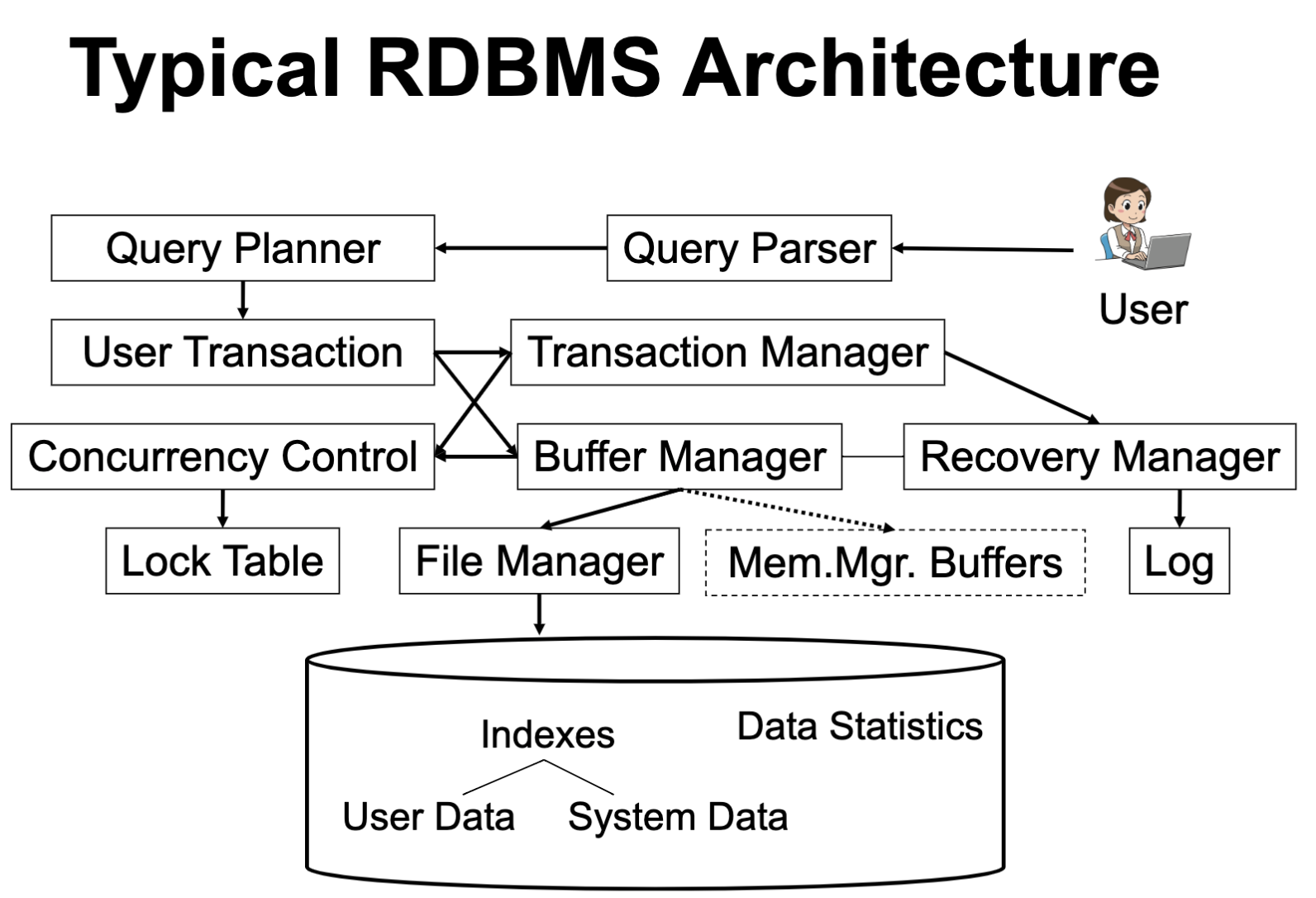
Boundaries
- Clear - modularity
- SQL language, query plan representation, pages & buffers
- Vague - interact with others
- Recovery + buffers + files + indexes
- Txns + indexes
- Data stat + query optimizer
OLTP vs OLAP
- OLTP: focus on concurrent, small, low-latency transactions (e.g. MySQL, Postgres, Oracle, DB2) → real-time apps
- OLAP: focus on large, parallel but mostly read-only analytics (e.g. Teradata, Redshift, Vertica) → “data warehouses”
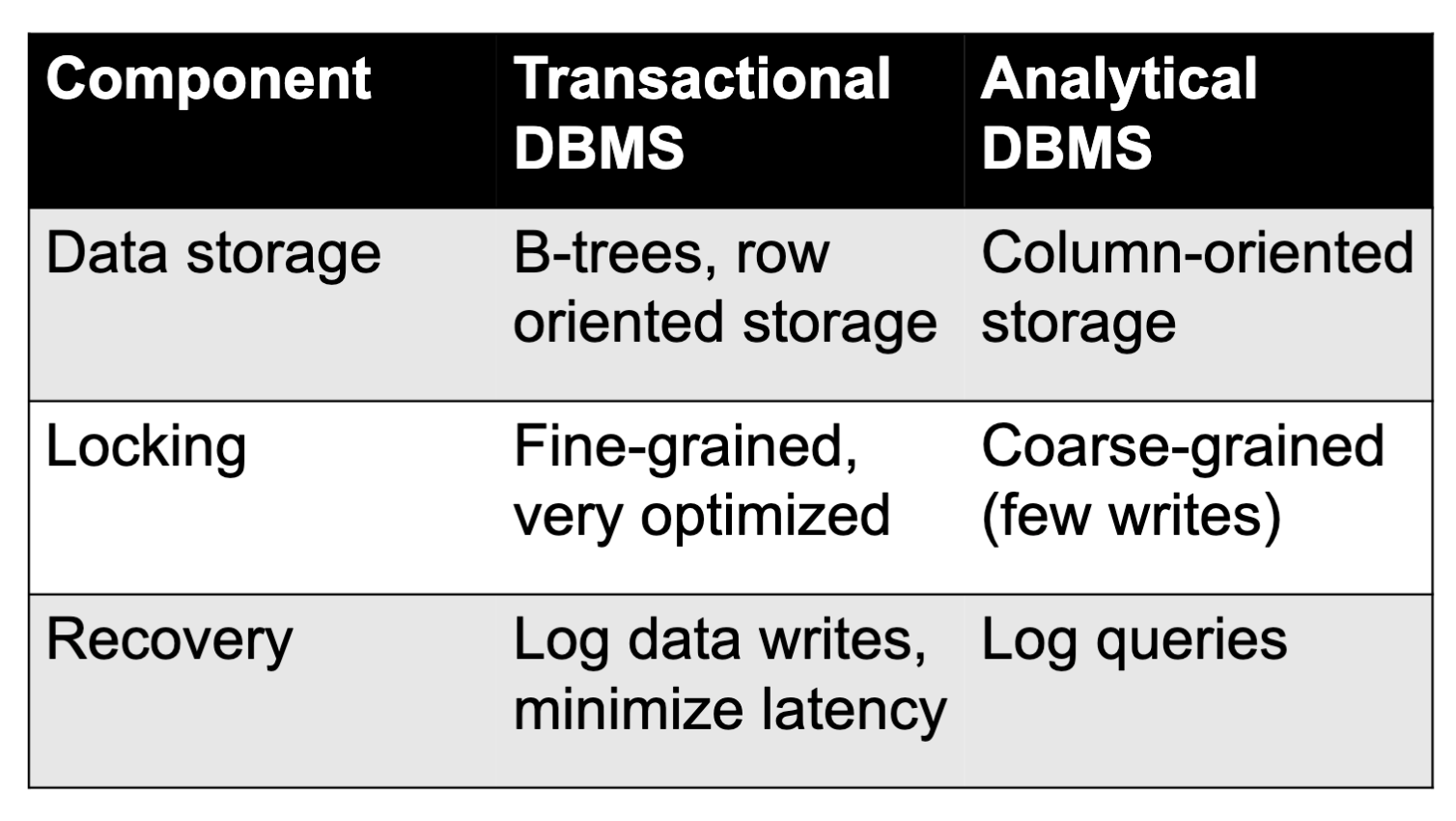
Alternative arch & tradeoffs
Potential ways to change DBMS arch
- Decouple query processing from storage management
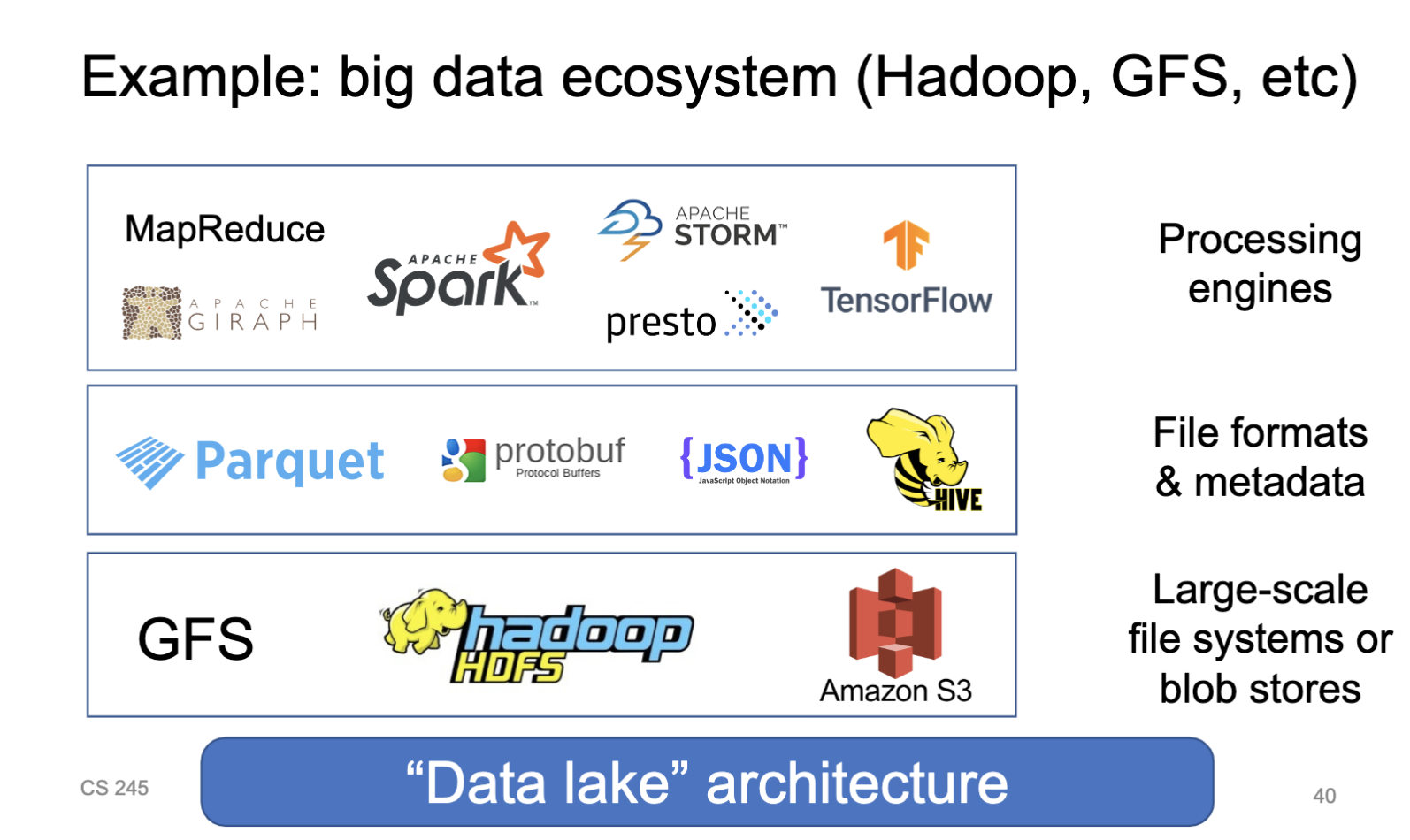
- Pros
- Can scale compute independently of storage (e.g. in datacenter or public cloud)
- Let different orgs develop different engines
- Your data is “open” by default to new tech
- Cons
- Harder to guarantee isolation, reliability, etc
- Harder to co-optimize compute and storage
- Can’t optimize across many compute engines
- Harder to manage if too many engines!
- Change the model
- Key-value stores: data is just key-value pairs, don’t worry about record internals
- Message queues: data is only accessed in a specific FIFO order; limited operations
- ML frameworks: data is tensors, models, etc
- Stream processing: apps run continuously and system can manage upgrades, scale-up, recovery, etc
- Eventual consistency: handle it at app level
- Different hardware setting
- Distributed databases: need to distribute your lock manager, storage manager, etc, or find system designs that eliminate them
- Public cloud: “serverless” databases that can scale compute independently of storage (e.g. AWS Aurora, Google BigQuery)
1.1.3. Storage Formats & Indexing
Storage hardware
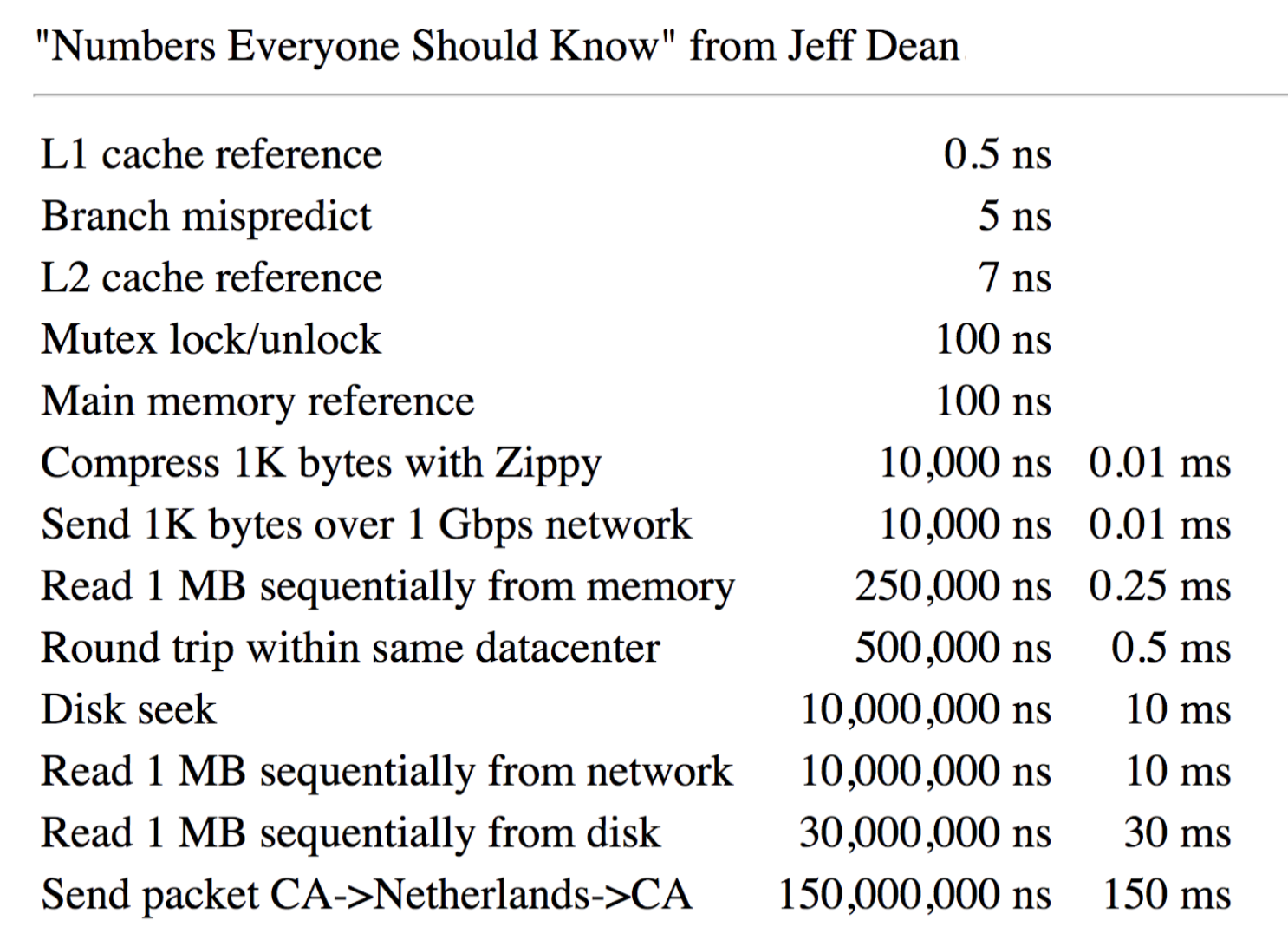
Max attainable throughput
- 100 GB/s for RAM
- 2 GB/s for NVMeSSD
- 130 MB/s for hard disk
Storage cost ($1000)
- 0.25 TB of RAM
- 9 TB of NVMe SSD
- 50 TB of magnetic disk
Hardware trends
- Capacity/$grows exponentially at a fast rate (e.g. double every 2 years)
- Throughput grows at a slower rate (e.g. 5% per year), but new interconnects help
- Latency does not improve much over time
Disk Access Time = Seek Time + Rotational Delay + Transfer Time + Other (details omitted)
The 5 Minute Rule for Trading MemoryAccesses for Disc Accesses (by Jim Gray & Franco Putzolu)
- Say a page is accessed every X seconds
- Assume a disk costs D dollars and can do I operations/sec; cost of keeping this page on disk is $C{d i s k}=C{i o p} / X=D /(I X)$
- Assume 1 MB of RAM costs M dollars and holds P pages; then the cost of keeping it in DRAM is $C_{m e m}=M / P$
- This tells us that the page is worth caching when $C{mem}< C{disk}$, i.e.
Summary
- Storage devices offer various tradeoffs in terms of latency, throughput and cost
- In all cases, data layout and access pattern matter because random ≪ sequential access
- Most systems will combine multiple devices
Record encoding
Types of records
- Fixed/variable format/length
- Fixed format: A schema(not record) contains #/type/order/meaning of fields
- Variable format: Record itself contains format (self-describing)
- Useful for “sparse” records, repeating fields, evolving formats, but may waste space
- Format: record header + fields
- Header: type (pointing to one of the schemas) + length + timestamps + concurrency stuff + etc.
Compression & encryption
Collection storage
Questions
- How do we place data items and records for efficient access?
- Locality and searchability (quickly find relevant records, e.g. using sorting)
- Locality - row/col store, hybrids (e.g. one field using col-store, the other two fields, potentially co-accessed, using row-store)
- Searchability
- Ordering
- Partitions - place data into buckets based on a field (e.g. time, but not necessarily fine-grained order) - make it easy to add, remove & list files in any directory
- Can We Have Searchability on Multiple Fields at Once?
- Multiple partition or sort keys (e.g. partition data by date, then sort by customer ID)
- Interleaved orderings such as Z-ordering
- How do we physically encode records in blocks and files?
- Separating records
- Fixed size records
- Special marker
- Given record lengths/offsets (within each rec. or in block header)
- Spanned vs. unspanned
- Unspanned - records must be within one block - simpler but waste space
- Spanned - need indication of partial record - essential if rec. size > block size
- Indirection - How does one refer to records? Physical vs. indirect.
- Purely physical - record addr/id = {block id = {block/track/cylinder #}, offset in block}
- Fully indirect - record id is arbitrary string - using map: id $\mapsto$ physical addr.
- Tradeoff: flexibility (of moving records) vs. cost (of indirection)
- Deletion and insertion
- Separating records
Summary
- There are 10,000,000 ways to organize my data on disk...
- Issues: flexibility, space utilization, complexity, performance
- Evaluation of a strategy
- Space used for expected data
- Expected time to
- Fetch record given/next key
- Insert/append/del/update records
- Read all file
- Reorganize file
Storage & compute co-design
C-Store (-> Vertica)
Compression
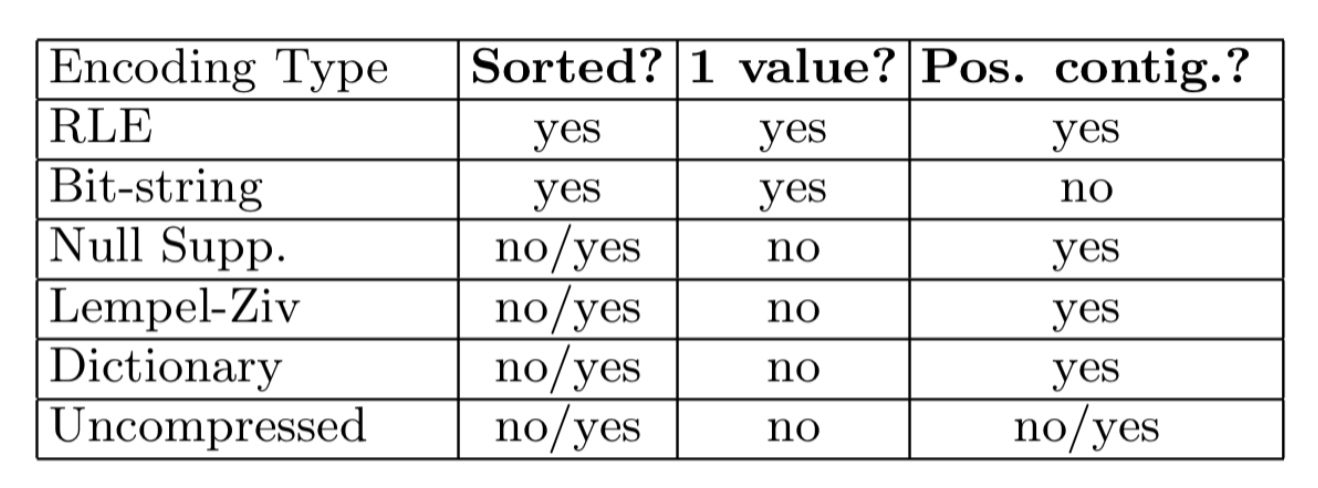
Indexes
Tradeoffs - size of indexes, cost to update indexes, query time
Types - conventional, b-trees, hash indexes, multi-key indexing
Sparse vs. dense
- Sparse better for insertion, dense needed for secondary indexes
With secondary indexes
- Lowest level is dense, other levels are sparse
- Pointers are record pointers (not block)
- Duplicate values - buckets
Conventional indexes
- Pros - simple, index is sequential (good for scan)
- Cons - expensive inserts, no balance
B-trees
Motivation: give up sequential to get balanced
B+ tree insertion/deletion
Hash indexes
- Hash vs tree indexes
- O(1) disk access instead of O(logN)
- Can't efficiently do range queries
- Resizing
- Hash tables try to keep occupancy in a fixed range (50-80%) and slow down beyond that -> Too much chaining
- How to resize?
- In memory - just move everything, amortized cost is pretty low
- On disk - moving everything is expensive
- Extendible hashing - Tree-like design for hash tables that allows cheap resizing while requiring 2 IOs / access
- Multi-key indexing
- K-d tree - splits dimensions in any order to hold k-dimensional data
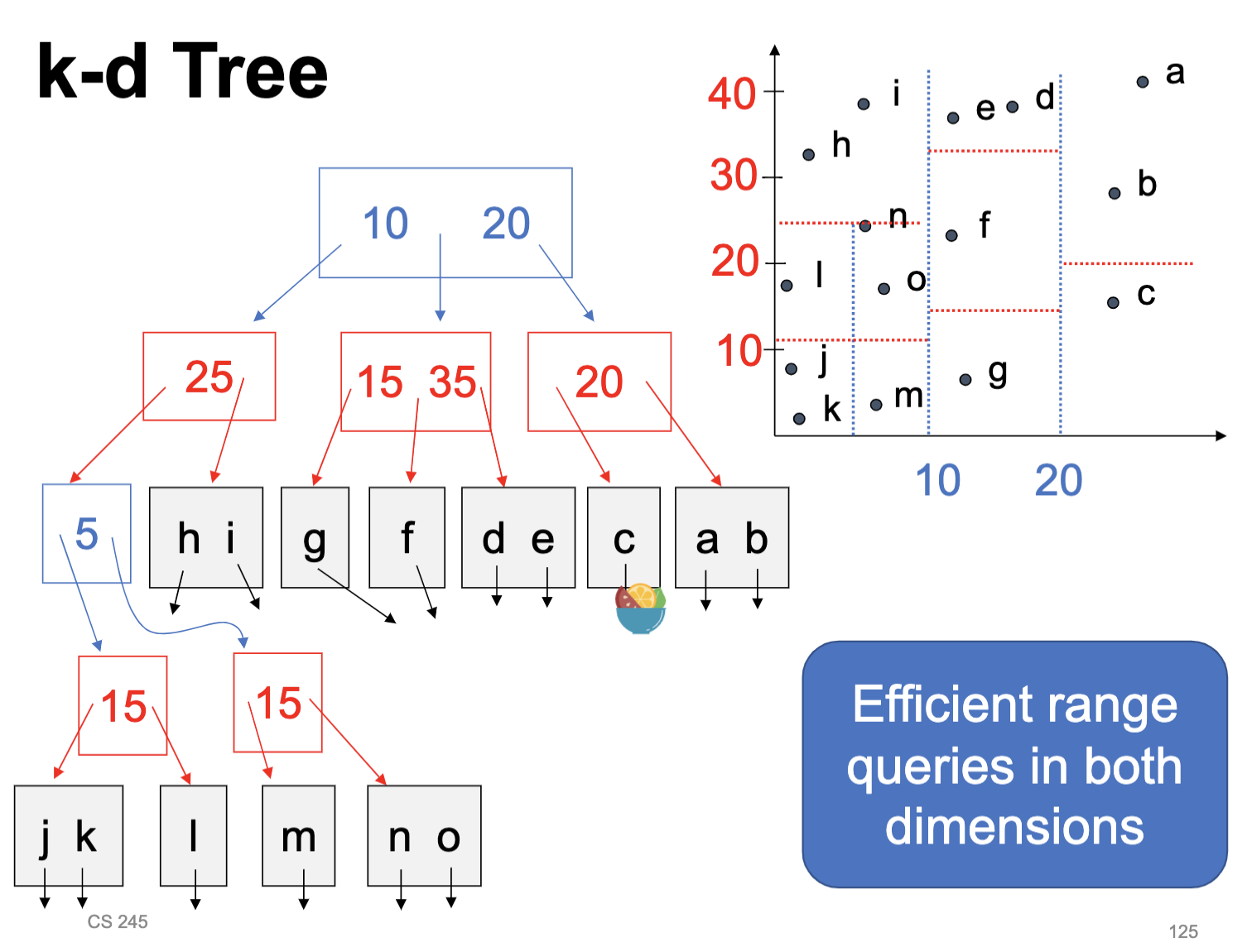
Storage system examples
- MySQL - transactional DBMS
- Row-oriented storage with 16 KB pages
- Variable length records with headers, overflow
- Index types - B-tree, hash (in-memory only), R-tree (spatial data), inverted lists for full text search
- Can compress pages with Lempel-Ziv
- Apache Parquet + Hive - analytical data lack
- Col-store as set of ~1 GB files (each file has s slice of all columns)
- Various compression and encoding schemes at the level of pages in a file
- Special scheme for nested fields (Dremel)
- Header with statistics at the start of each file
- Min/max of columns, nulls, Bloom filter
- Files partitioned into directories by one key
1.1.4. Query Execution & Optimization
Overview
Query execution overview
- Query representation (e.g. SQL)
- Logical query plan (e.g. relational algebra)
- Optimized logical plan
- Physical plan (code/operators to run)
- Many execution methods - per-record execution, vectorization, compilation
Plan optimization methods
- Rule-based - systematically replace some expressions with other expressions
X OR TRUE->TRUE, M*A + M*B -> M*(A+B)
- Cost-based - propose several execution plans and pick best based on a cost model
- Adaptive - update execution plan at runtime
Execution methods
- Interpretation - walk through query plan operators for each record
- Vectorization - walk through in batches
- Compilation - generate code (like in System R)
Typical RDBMS execution

Relational operators
Relational algebra
- Codd's original - tables are sets of tuples; unordered and tuples cannot repeat
- SQL - tables are bags (multi-sets) of tuples; unordered but each tuple may repeat
Operators
- Intersection, union, difference, Cartesian Product
- Selection, projection, natural join, aggregation
- Properties
SQL query example
- Find the movies with stars born in 1960
SELECT title FROM Stars In WHERE starName IN (SELECT name FROM MovieStar WHERE birthdate LIKE ‘%1960’); - Parse tree
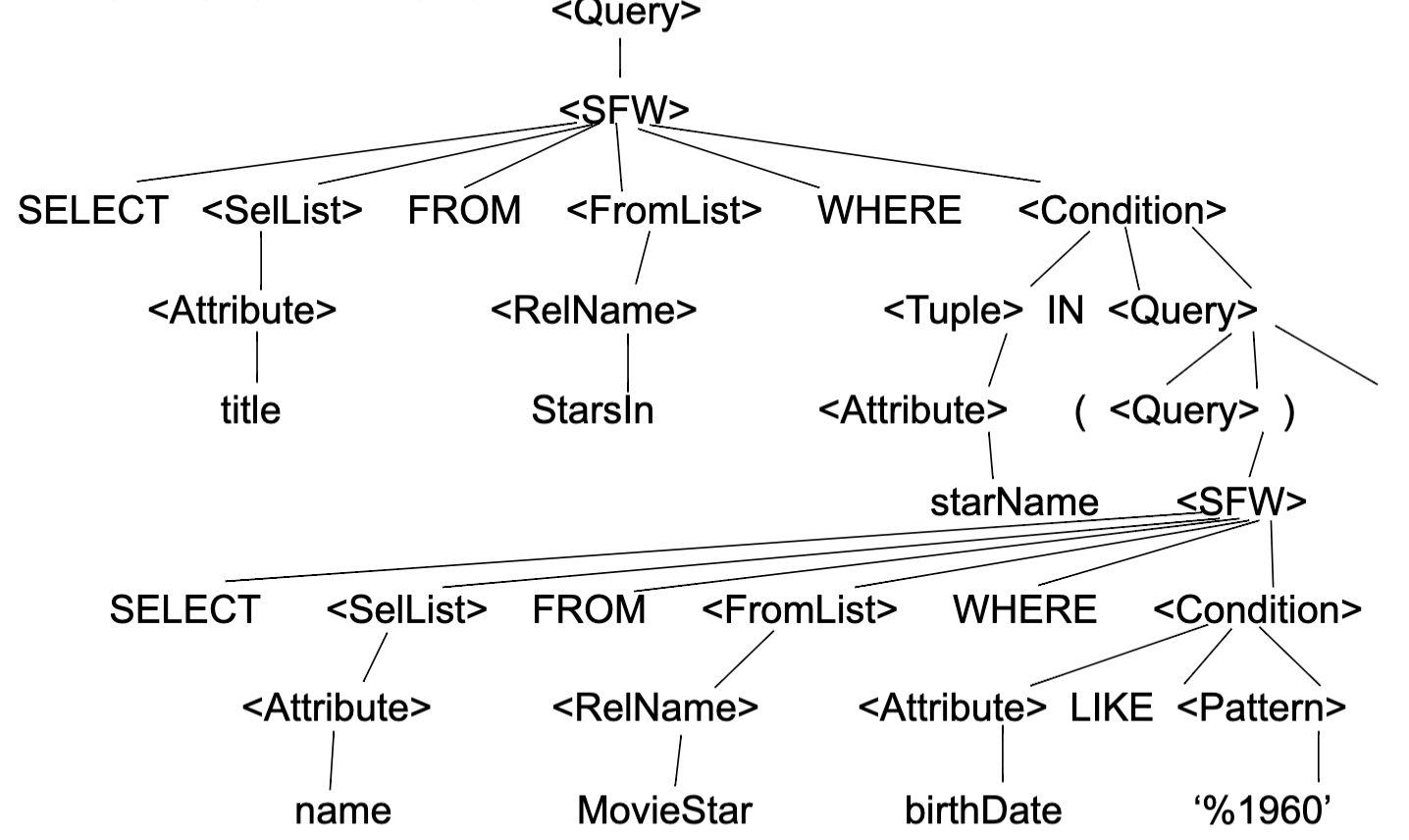
- Logical query plan
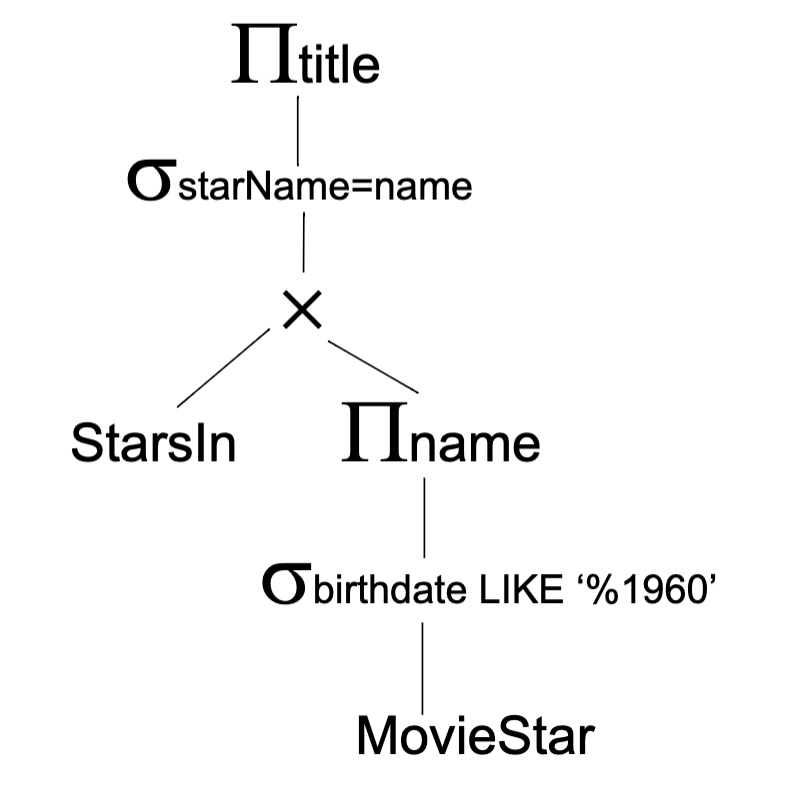
- Physical plan (Index scan and sequence scan can swap)
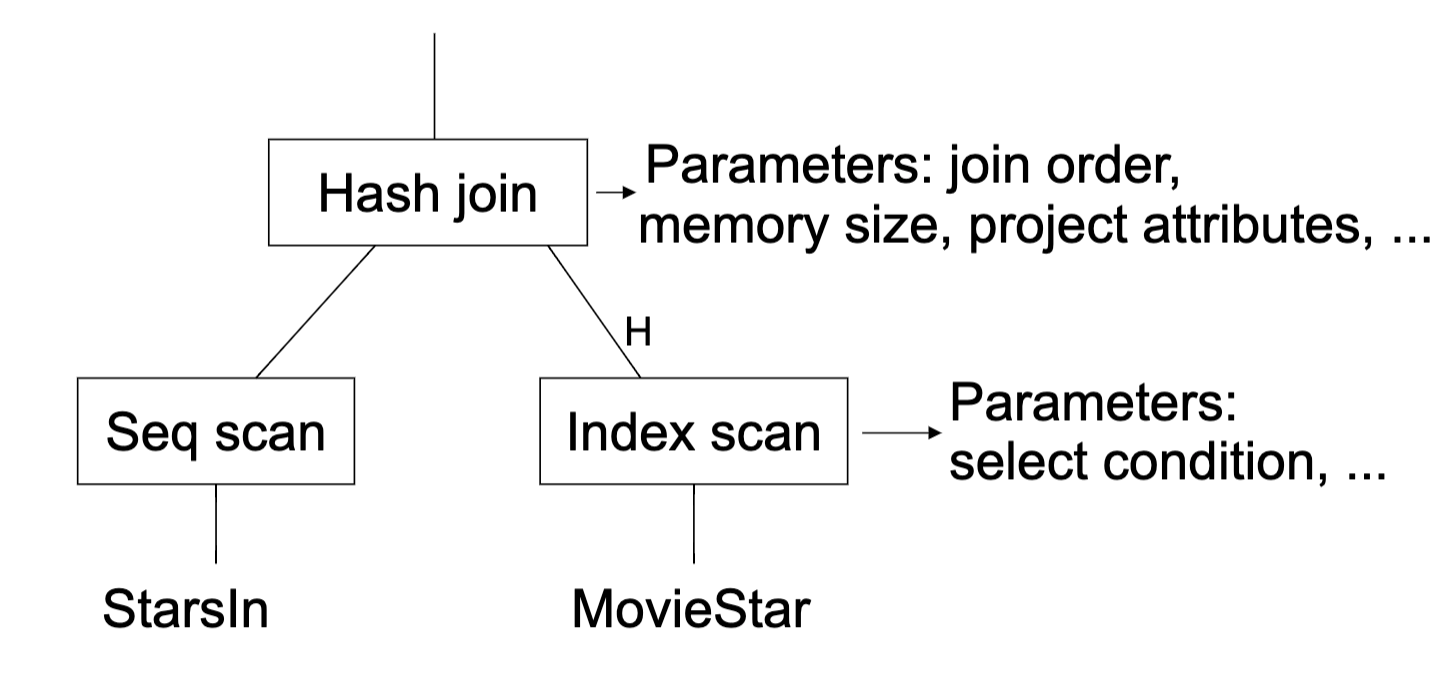
Execution methods
- Interpretation
- Recursively calls Operator.next() and Expression.compute()
- Vectorization
- Interpreting query plans one record at a time is simple but also slow
- Lots of virtual function calls and branches for each record
- Keep recursive interpretation, but make Operators and Expressions run on batches
- Implementation
- Tuple batches fit in L1 or L2 cache
- Operators use SIMD instructions to update both values and null fields without branching
- Pros - Faster when processing many records, relatively simple to implement
- Cons - Lots of nulls in batches if query is selective, data travels between CPU & cache a lot
- Interpreting query plans one record at a time is simple but also slow
- Compilation
- Turn the query into executable code
- Pros - potentially fastest, leverage modern compilers
- Cons - complex to implement, compilation takes time, generated code may not match hand-written
Modern choice
- OLTP (MySQL) - mostly record-at-a-time interpretation
- OLAP (Vertica, Spark SQL) - vectorization, sometimes compilation
- ML libs (TensorFlow) - mostly vectorization (records are vectors), sometimes compilation
Optimize target
Target
- Operator graph - what operators do we run, and in what order?
- Operator implementation - for operators with several implementations (e.g. join), which one to use?
- Access paths - how to read each table? Index scan, table scan, C-store projections, etc.
Challenge
- Exponentially large set of possible query plans (...similar to TASO)
- We need techniques to prune the search space and complexity involved
Rule-based optimization
Rule (...pattern or template)
Def - Procedure to replace part of the query plan based on a pattern seen in the plan
Implementation
- Each rule is typically a function that walks through query plan to search for its pattern.
- Rules are often grouped into phases (e.g. simplify boolean expressions, pushdown selects, choose join algorithms)
- Each phase run rules till they no longer apply
- Combined simple rules can optimize complex query plans (if designed well)
Example - Spark SQL's Catalyst Optimizer
Written in Scala to use its pattern matching
> 1000 types of expressions, hundreds of rules
Common rule-based optimizations
- Simplifying expressions in select, project, etc
- Boolean algebra, numeric expressions, string expressions, etc.
- Many redundancies because queries are optimized for readability or generated by code
- Simplifying relations operators graphs
- Select, project, join, etc. - These relational optimizations have the most impact
- Simplifying access patterns and operator implementations in simple cases - Also very high impact
- Index column predicate -> use index
- Small table -> use hash join against it
- Aggregation on field with few values -> use in-memory hash table
- Rules also often used to do type checking and analysis (easy to write recursively)
Common relational rules
- Push selects as far down the plan as possible - reduce # of records early to minimize work in later ops; enable index access paths
- Push projects as far down as possible - don't process fields that you'll just throw away
- Be careful - project rules can backfire
Bottom line
- Many possible transformations aren't always good for performance
- Need more info to make good decisions
- Data stats - properties about our input or intermediate data to be used in planning
- Cost models - how much time will an operator take given certain input data stats?
Data statistics
Data stats
- Def - info about tuples in a relation that can be used to estimate size and cost
- Example - # of tuples, avg size of tuples, # distinct values for each attribute, % of null values for each attribute
- Typically maintained by the storage engines as tuples are added/removed in a relation
- File formats like Parquet (col-stored) can also have them
- Challenge - how to keeps stats for intermediate tables during a query plan?
- Stat estimation methods based on assumptions (should balance speed, accuracy and consistency)
- Omitted. Please refer to examples in slides.
Cost models
How do we measure a query plan's cost?
- # disk IOs (focus), # of compute cycles
- Combined time metric, memory usage, bytes sent on network
- Example - index vs table scan
Join operators
- Join orders and algorithms are often the choices that affect performance the most
- Common join algorithms
- Iterator (nested loops) join - cost = [B(R1) + T(R1) B(R2)] reads + [B(R1⨝R2)] writes
- Merge join - cost = [B(R1) + B(R2)] reads + [B(R1⨝R2)] writes + (if not sorted, 4B(Ri) I/Os)
- Join with index - read cost = B(R1) + T(R1) (L~index~+ L~data~)
- Hash join - read cost = B(R1) + B(R2)
- Hash join in memory/disk
- Trick: hash (key, pointer to records) and sort pointers to fetch sequentially
- If joins very selective, may prefer methods that join pointers or do index lookups
In general, the following are used
- Index join if an index exists
- Merge join if at least one table is sorted
- Hash join if both tables unsorted
Cost-based plan selection
Process - generate plans -> prune -> estimate cost -> pick min cost
How to generate plans
- Can limit sear space - many dbs only consider left-deep joins
- Can prioritize searching through the most impactful decisions first - e.g. join order
How to prune
- Throw current plan away if it's worse than best so far
- Use greedy to find an "OK" initial plan that will allow lots of pruning
- Memoization - remember cost estimates and stats for repeated subplans
- Dynamic programming - can pick an order to subproblems to make it easy to reuse results
Resource cost
- It's possible for cost-based optimization itself to take longer than running the query.
- Luckily, a few big decisions drive most off the query execution time (e.g. join order)
Spark SQL
History
Resilient distributed datasets (RDDs)
- Immutable collections of objects that can be stored in memory/disk across a cluster
- Bulit with parallel transformations (map, filter, etc.)
- Automatically rebuilt on failure
Challenges with Spark's original functional API
- Looks high-level, but hides many semantics of computation from engine
- Functions passed in are arbitrary blocks of code
- Data stored is arbitrary java/python objects. Java objects often many times larger than data.
- Users can mix APIs in suboptimal ways
Spark SQL & DataFrames - efficient lib for working with structured data
2 interfaces: SQL for data analysts and external apps, DataFrames for complex programs
Optimized computation and storage underneath
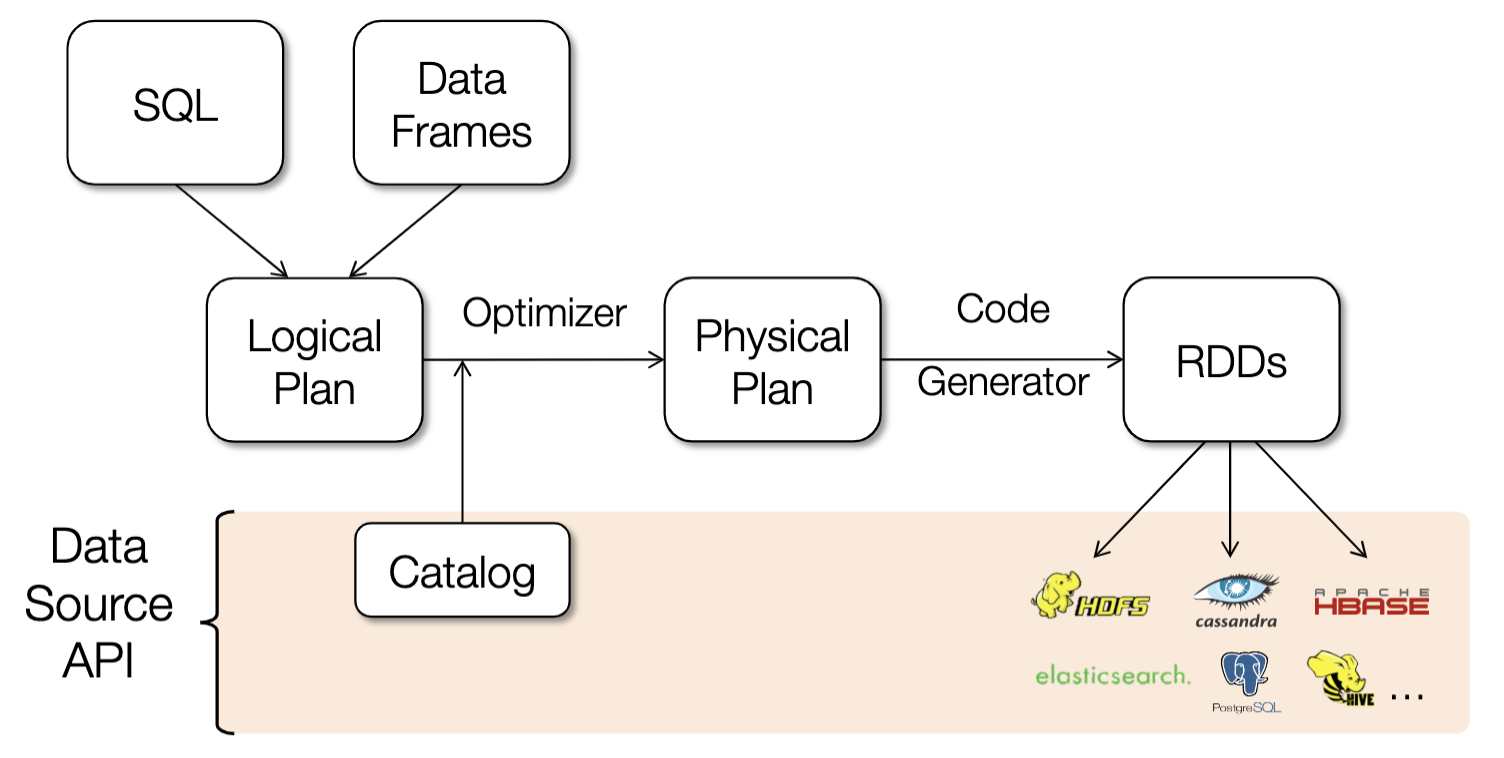
DataFrames hold rows with a known schema and offer relational operations through a DSL
- Based on data frame concept in R, python, Spark is the first to make this declarative
- Integrated with the rest of Spark - ML lib, easily convert RDDs
What DataFrames Enable
- Compact binary representation - columnar, compressed cache; rows for processing
- Optimization across operators (join reordering, predicate pushdown, etc)
- Runtime code generation
Uniform ways to access structured data
- Apps can migrate across Hive, Cassandra, Json, Parquet
Rich semantics allows query pushdown into data sources.

Extensions to Spark SQL
- Tens of data sources using the pushdown API
- Interval queries on genomic data, Geospatial package (Magellan)
- Approximate queries & other research
1.1.5. Transactions & Recovery
Defining correctness, transaction model, hardware failures, recovery with logs, undo/redo logging
Def, undo logging, redo logging, checkpoints
Problems with ideas so far
- Undo logging: need to wait for lots of I/O to commit; can’t easily have backup copies of DB
- Redo logging: need to keep all modified blocks in memory until commit
-> Undo/redo logging
- Backward pass (end of log → latest valid checkpoint start)
- construct set S of committed transactions
- undo actions of transactions not in S
- Undo pending transactions
- follow undo chains for transactions in(checkpoint’s active list) -S
- Forward pass (latest checkpoint start → end of log)
- redo actions of all transactions in S

Media failures = Loss of nonvolatile storage -> make copies
When can logs be discarded?
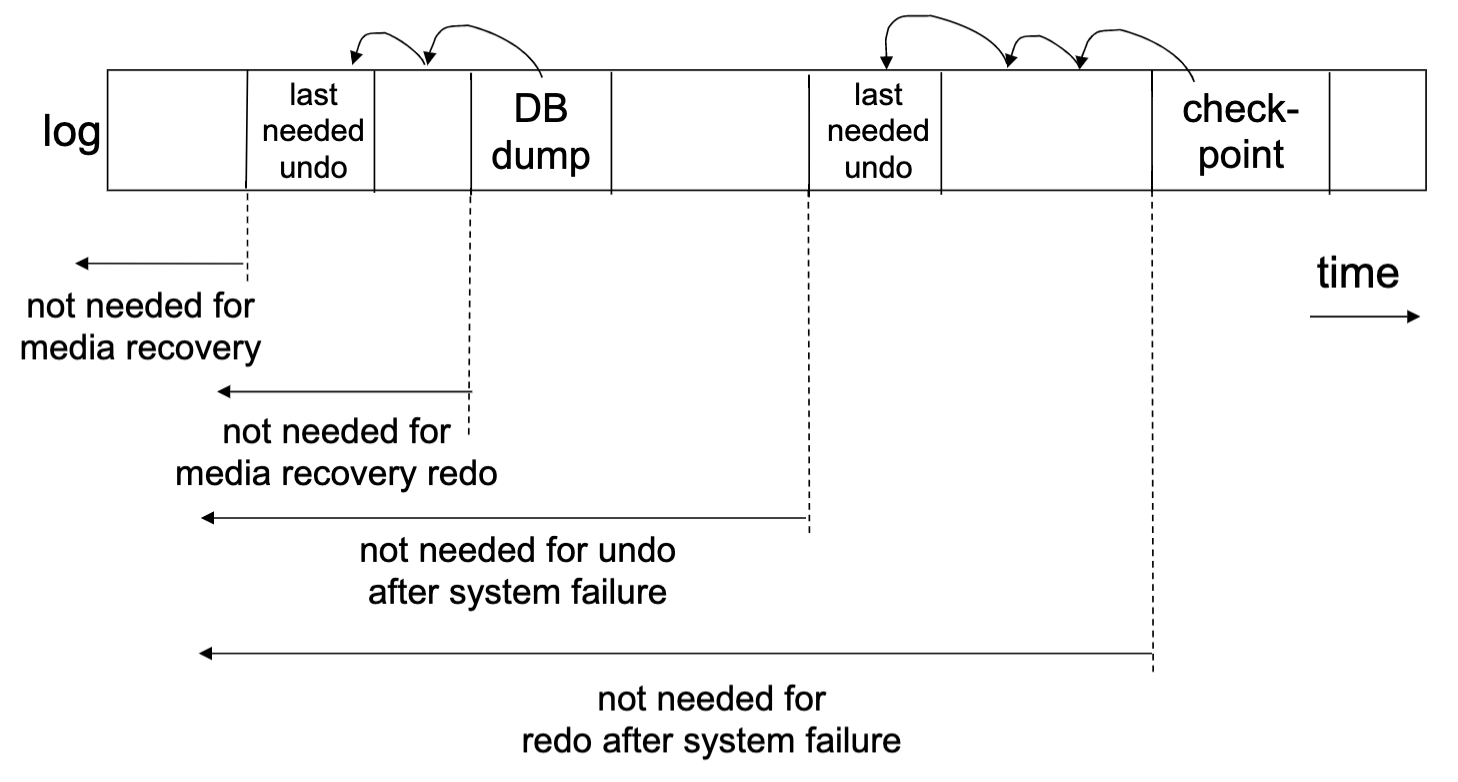
Summary = logging + redundancy
For details about this section, please refer to slides or any common database courses.
1.1.6. Concurrency
Isolation levels
- Strong isolation - easier to reason about (can't see others' change)
- Weak isolation - see others' changes, but more concurrency
- Virtually no commercial DBs do serializability by default, and some can’t do it at all

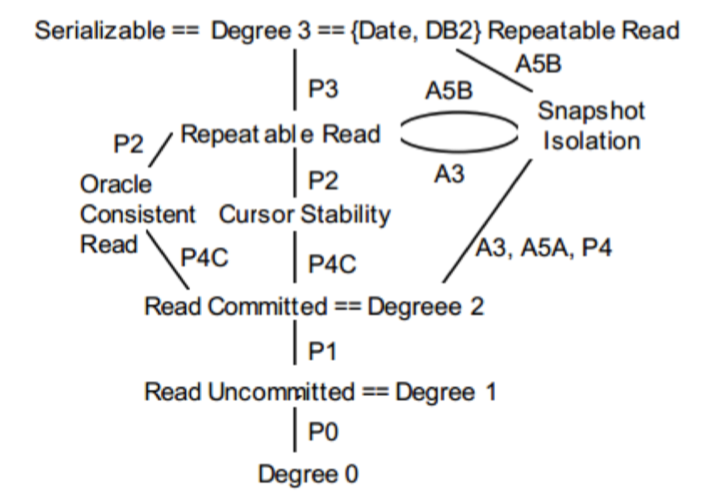
Serializability
Concepts
- Transaction: sequence of r~i~(x), w~i~(x) actions
- Schedule:a chronological order in which all the transactions’ actions are executed
- Conflicting actions: pairs of actions that would change the result of a read or write if swapped
- Schedules S1, S2 are conflict equivalent if S1can be transformed into S2by a series of swaps of non-conflicting actions(i.e., can reorder non-conflicting operations in S1 to obtain S2)
- A schedule is conflict serializable if it is conflict equivalent to some serial schedul
- Precedence graphs
- If S1, S2 conflict equivalent, then P(S1) = P(S2). But the reverse is not true
- P(S1) acyclic <=> S1 conflict serializable
2PL & OCC
2PL
- Def, correctness proof
- Optimzing performance
- Shared locks
- Multiple granularity
- Tree representation - fields, tuples, tables, relations...
- Lock variants
- Inserts, deletes and phantoms
- Other types of C.C. mechanisms
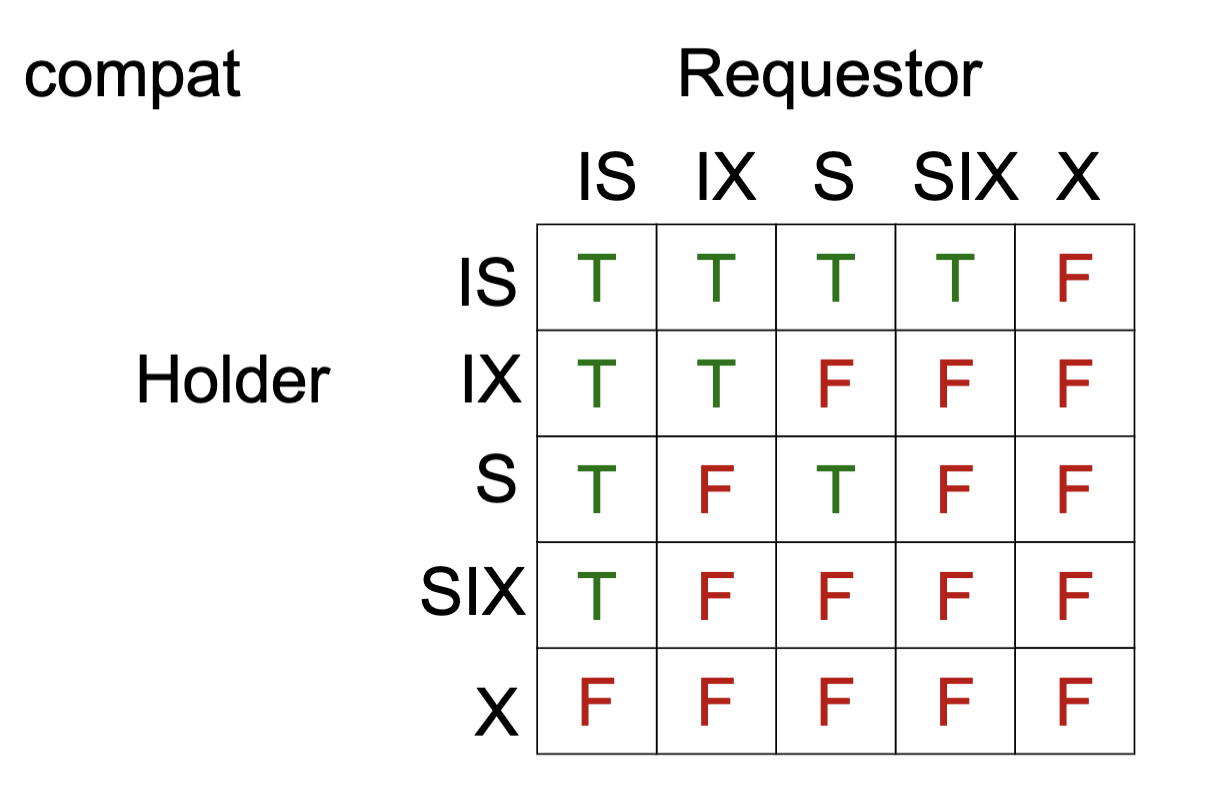
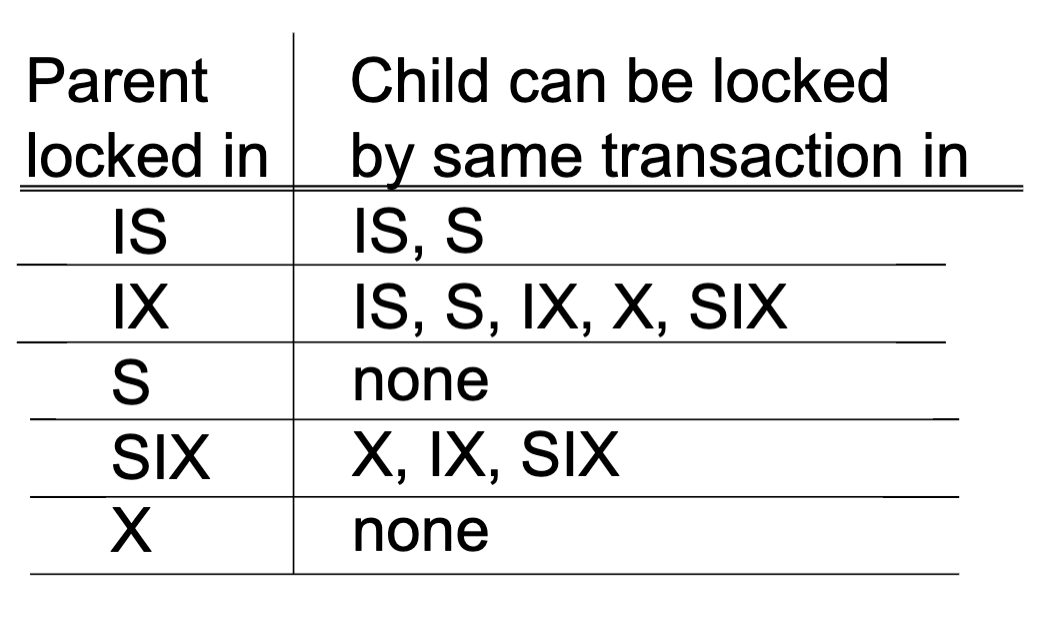
Validation performs better than locking when
- Conflicts are rare
- System resources are plentiful
- Have tight latency constraints
For details about this section, please refer to slides or any common database courses.
Concurrency control & recovery
Recoverable schedule
- S is recoverable if each transaction commits only after all transactions from which it read have committed
- S avoids cascading rollback if each transaction may read only those values written by committed transactions
- S is strict if each transaction may read and write only items previously written by committed transactions (≡ strict 2PL)
- With OCC, no actions is needed. Each transaction’s validation point is its commit point, and only write after.
- Serial ⊂ strict ⊂ avoids cascading rollback ⊂ recoverable
- Example
- Recoverable: w1(A) w1(B) w2(A) r2(B) c1c2
- Avoids Cascading Rollback: w1(A) w1(B) w2(A) c1 r2(B) c2
- Strict: w1(A) w1(B) c1w2(A) r2(B) c2
- Every strict schedule is serializable.
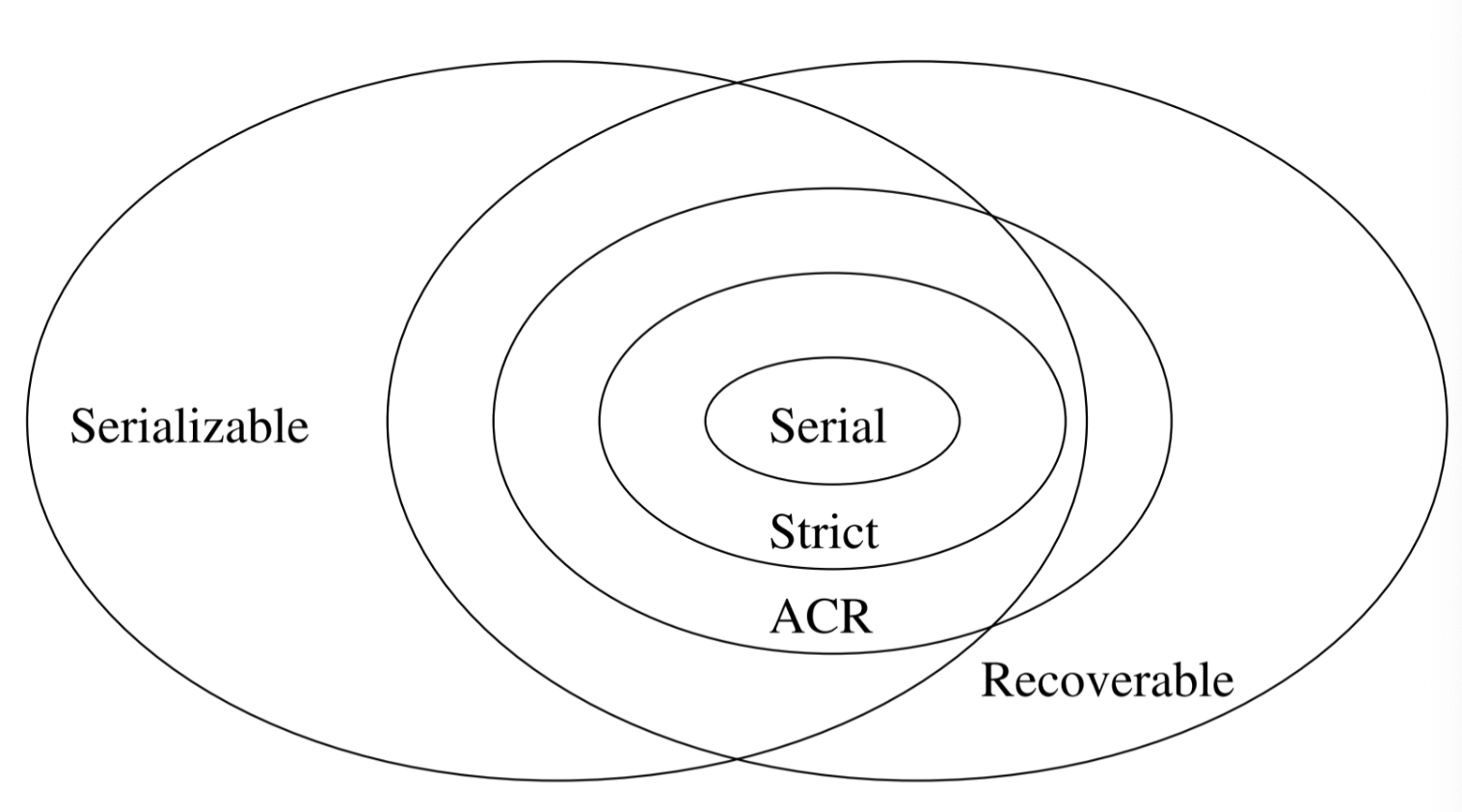
Beyond serializability
Weaker isolation levels
- Dirty reads
- Let transactions read values written by other uncommitted transactions
- Equivalent to having long-duration write locks, but no read locks
- Read committed
- Can only read values from committed transactions, but they may change
- Equivalent to having long-duration write locks (X) and short-duration read locks (S)
- Repeatable reads
- Can only read values from committed transactions, and each value will be the same if read again
- Equivalent to having long-duration read & write locks (X/S) but not table locks for insert
- Snapshot isolation
- Each transaction sees a consistent snapshot of the whole DB (as if we saved all committed values when it began)
- Often implemented with MVCC
Facts
- Oracle calls their snapshot isolation level “serializable”, and doesn’t provide serializable
- Many other systems provide snapshot isolation as an option
- MySQL, PostgreSQL, MongoDB, SQLServer
For details about this section, please refer to slides or any common database courses.
1.1.7. Distributed Systems
Replication
General problem: how to tolerate server/network failures
The eight fallacies of distributed computing (by Peter Deutsch)
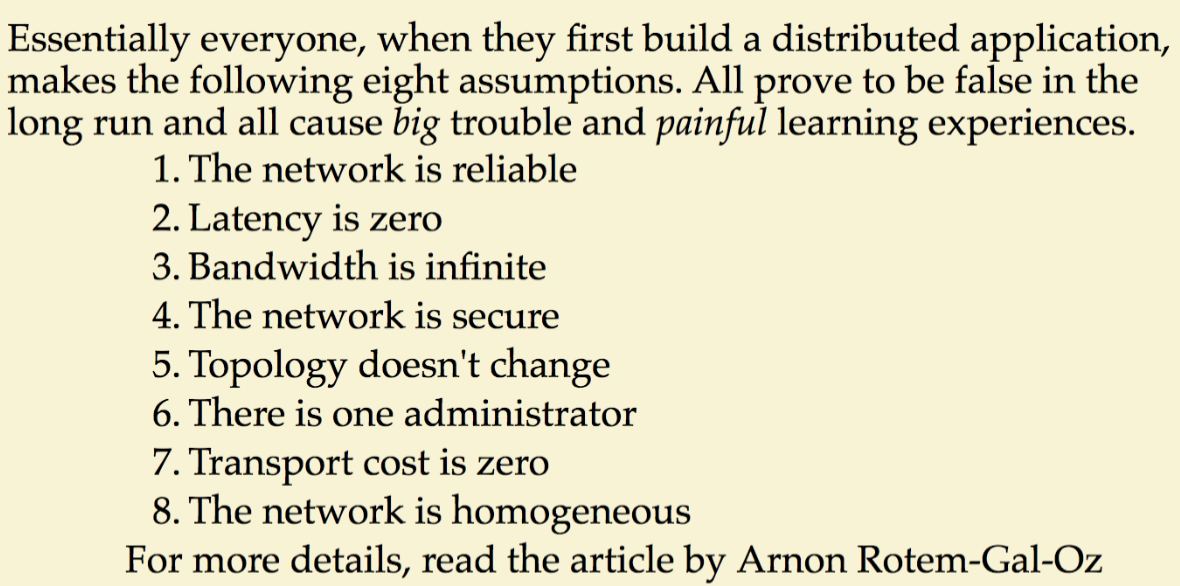
Replication
- Primary-backup
- 1 primary + n backup
- send requests to primary, which then forwards operations or logs to backups
- Sync/async backup coordination
- Quorum replication
- Read and write to intersecting sets of servers; no one “primary”
- Common: majority quorum - More exotic ones exist, like grid quorums
- Surprise: primary-backup is a quorum too!
- Eventual consistency - If writes stop, eventually all replicas will contain the same data - async broadcast all write to all replicas
Solutions to failures - consensus
- {Paxos, Raft} + {modern implementations: Zookeeper, etcd, Consul}
- Idea - keep a reliable, distributed shared record of who is primary
- Distributed agreement on one value/log of events
Partitioning
Split database into chunks called partitions
- Typically partition by row
- Can also partition by column (rare)
Partition strategies
- Hash key to servers - random assignment
- Partition keys by range - keys stored contiguously
- What if servers fail (or we add servers)? - Rebalance partitions using consensus.
Distributed transactions
- Replication
- Must make sure replicas stay up to date
- Need to reliably replicate the commit log (using consensus or primary-backup)
- Partitioning
- Must make sure all partitions commit/abort
- Need cross-partition concurrency control
Atomic commitment & 2PC
Atomic commitment (in a distributed transaction) - Either all participants commit a transaction, or none do
2PC + OCC
- Participants perform validation upon receipt of prepare message
- Validation essentially blocks between prepare and commit message
2PC + 2PL
- Traditionally: run 2PC at commit time
- i.e., perform locking as usual, then run 2PC to have all participants agree that the transaction will commit
- Under strict 2PL, run 2PC before unlocking the write locks
2PC + logging
- Log records must be flushed to disk on each participant before it replies to prepare
- The participant should log how it wants to respond + data needed if it wants to commit
Optimizations
- Participants can send prepared messages to each other
- Can commit without the client
- Requires O(P^2^) messages
- Piggyback transaction’s last command on prepare message
- 2PL - piggyback lock “unlock” commands on commit/abort message
Possible failures - unavailable coordinators/participants, or both
Every atomic commitment protocol is blocking(i.e., may stall) in the presence of
- Asynchronous network behavior (e.g., unbounded delays) -> Cannot distinguish between delay and failure
- Failing nodes -> If nodes never failed, could just wait
CAP
Async network model
- Message can be arbitrary delayed
- Can't distinguish between delayed messages and failed nodes in a finite amount of time
CAP Theorem
- In an async network, a distributed database can either (not both)
- guarantee a response from any replica in a finite amount of time (“availability”) OR
- guarantee arbitrary “consistency” criteria/constraints about data
- Choose either
- Consistency and “Partition Tolerance”
- Availability and “Partition Tolerance”
- “CAP” is a reminder - No free lunch for distributed systems
Why CAP is important
- Pithy reminder: “consistency” (serializability, various integrity constraints) is expensive!
- Costs us the ability to provide “always on” operation (availability)
- Requires expensive coordination (synchronous communication) even when we don’t have failures
Avoiding coordination
Why need avoid coordination
- How fast can we send messages? - Planet Earth: 144ms RTT
- Message delays often much worse than speed of light (due to routing)
- Key finding - most applications have a few points where they need coordination, but many operations do not.
- Serializability has a provable cost to latency, availability, scalability (if there are conflicts)
- We can avoid this penalty if we are willing to look at our application and our application does not require coordination
- Major topic of ongoing research
BASE idea = “Basically Available, Soft State, Eventual Consistency”
- Partition data so that most transactions are local to one partition (reduce # of cross-partition txns)
- Tolerate out-of-date data (eventual consistency)
- Caches, weaker isolation levels (causal consistency), helpful ideas (idempotence, commutativity)
- BASE Example
- Constraint:each user’s amt_sold and amt_bought is sum of their transactions
- ACID Approach - to add a transaction, use 2PC to update transactions table + records for buyer, seller
- One BASE approach - to add a transaction, write to transactions table + a persistent queue of updates to be applied later
- Another BASE approach:write new transactions to the transactions table and use a periodic batch job to fill in the users table
- Helpful ideas
- When we delay applying updates to an item, must ensure we only apply each update once
- Issue if we crash while applying!
- Idempotent operations - same result if you apply them twice
- When different nodes want to update multiple items, want result independent of msg order
- Commutative operations:A⍟B = B⍟A
- When we delay applying updates to an item, must ensure we only apply each update once
Parallel query execution
Read-only workloads (analytics) don’t require much coordination, so great to parallelize
Challenges with parallelism
Algorithms:how can we divide a particular computation into pieces (efficiently)?
- Must track both CPU & communication costs
Imbalance:parallelizing doesn’t help if 1 node is assigned 90% of the work
Failures and stragglers:crashed or slow nodes can make things break
Amdahl’s Law
Example System Designs
- Traditional “massively parallel” DBMS
- Tables partitioned evenly across nodes. Each physical operator also partitioned. Pipelining across these operators
- MapReduce
- Focus on unreliable, commodity nodes
- Divide work into idempotent tasks, and use dynamic algorithms for load balancing, fault recovery and straggler recovery
Example - distributed joins
- Shuffle hash join, broadcast join
- Broadcast join is much faster if |B| ≪|A| (use data stats to choose)
- Which algorithm is more resistant to load imbalance from data skew?
- Broadcast: hash partitions may be uneven!
Note
- Parallel queries optimizations
- Handling imbalance
- Choose algorithms, hardware, etc. (consistent hash) that is unlikely to cause load imbalance
- Load balance dynamically at runtime - over-partitioning, split running tasks
- Handling faults
- If uncommon, just ignore / call the operator / restart query
- Simple recovery
- Recovery time grows fast with N
- Parallel recovery - over-partition tasks; when a node fails, redistribute its tasks to the others
- Used in MapReduce, Spark, etc
- Recovery time doesn't grow with N
- Handling stragglers
- General idea:send the slow request/task to another node (launch a “backup task”)
- Threshold approach - slower than 99%, 1.5x avg etc., launch backup
- Progress-based approach - estimate task finish times (work_left/progress_rate) and launch tasks likeliest to finish last
Summary - Parallel execution can use many techniques we saw before, but must consider 3 issues
- Communication cost
- often ≫compute (remember our lecture on storage)
- Load balance - need to minimize the time when last op finishes, not sum of task times
- Fault recovery if at large enough scale
1.1.8. Security & Data Privacy
Key concepts and tools
Security goals
- Access Control: only the “right” users can perform various operations; typically relies on
- Authentication: a way to verify user identity (e.g. password)
- Authorization: a way to specify what users may take what actions (e.g. file permissions)
- Auditing: system records an incorruptible audit trail of who did each action
- Confidentiality: data is inaccessible to external parties (often via cryptography)
- Integrity: data can’t be modified by external parties
- Privacy: only a limited amount of information about “individual” users can be learned
Modern tools for security
- Privacy metrics and enforcement thereof(e.g. differential privacy)
- Computing on encrypted data (e.g. CryptDB)
- Hardware-assisted security (e.g. enclaves)
- Multi-party computation (e.g. secret sharing)
Differential privacy
Differential privacy
- Idea - A contract for algorithms that output statistics
- Intuition - the function is differentially private if removing or changing a data point does not change the output "too much"
- Intuition - plausible deniability [合理推诿,似是而非的否认]
- For A and B that differ in one element
- $\operatorname{Pr}[M(A) \in S] \leq e^{\varepsilon} \operatorname{Pr}[M(B) \in S]$
- Privacy parameter - Smaller ε ~= more privacy, less accuracy
- Private information is noisy.
- Pros
- Composition: can reason about the privacy effect of multiple (even dependent) queries
- Let queries Mi each provide εi-differential privacy; then the set of queries {Mi} provides Σiεi-differential privacy
- Adversary’s ability to distinguish DBs A & B grows in a bounded way with each query
- Parallel composition: even better bounds if queries are on disjoint subsets (e.g., histograms)
- Let Mi each provide ε-differential privacy and read disjoint subsets of the data Di; then the set of queries {Mi} provides ε-differential privacy
- Easy to compute: can use known results for various operators, then compose for a query
- Enables systems to automatically compute privacy bounds given declarative queries
- Composition: can reason about the privacy effect of multiple (even dependent) queries
- Cons
- Each user can only make a limited number of queries (more precisely, limited total ε) - Their ε grows with each query and can’t shrink
- How to set ε in practice?
- Computing DP bounds - details omitted.
- Use of DP
- Statistics collection about iOS features
- “Randomized response”: clients add noise to data they send instead of relying on provider
- Research systems that use DP to measure security (e.g. Vuvuzela messaging)
Other security tools
Computing on encrypted data
- Idea - some encryption schemes allow computing on data without decrypting it
- Usually very expensive, but can be done efficiently for some functions f
- Example Systems
- CryptDB, Mylar (MIT research projects), Encrypted BigQuery (CryptDB on BigQuery)
- Leverage properties of SQL to come up with efficient encryption schemes & query plans
- Example encryption schemes
- Equality checks with deterministic encryption, additive homomorphic encryption, fully homomorphic encryption, order-preserving encryption
Hardware enclaves
- Threat model: adversary has access to the database server we run on (e.g. in cloud) but can’t tamper with hardware
- Idea: CPU provides an “enclave” that can provably run some code isolated from the OS
- Enclaves returns a certificate signed by CPU maker that it ran code C on argument
- Already present in all Intel CPUs (Intel SGX), and many Apple custom chips (T2, etc)
- Initial applications were digital rights mgmt., secure boot, secure login
- Protect even against a compromised OS
- Some research systems explored using these for data analytics: Opaque, ObliDB, etc.
Databases + enclaves (performance is fast too (normal CPU speed))
- Store data encrypted with an encryption scheme that leaks nothing (randomized)
- With each query, user includes a public key k~q~ to encrypt the result with
- Database runs a function f in the enclave that does query and encrypts result with k~q~
- User can verify f ran, DB can’t see result!
Oblivious algorithms - same access pattern regardless of underlying data, query results, etc.
Multi-Party Computation (MPC)
- Threat model: participants p1, ..., pn want to compute some joint function f of their data but don’t trust each other
- Idea: protocols that compute f without revealing anything else to participants
- Like with encryption, general computations are possible but expensive
- Secret sharing
Lineage Tracking and Retraction
- Goal: keep track of which data records were derived from an individual input record
- Examples - Facilitate removing a user’s data in GDPR, verifying compliance, etc
- Some real systems provide this already at low granularity, but could be baked into DB
1.1.9. Cloud Systems
Cloud DBs
Def & diff
Computing as a service, managed by an external party
- Software as a Service (SaaS) - application hosted by a provider, e.g. Salesforce, Gmail
- Platform as a Service (PaaS) - APIs to program against, e.g. DB or web hosting
- Infrastructure as a Service (IaaS) raw computing resources, e.g. VMs on AWS
Public vs. private
- Public cloud = the provider is another company (e.g.AWS, Microsoft Azure)
- Private cloud = internal PaaS/IaaS system (e.g. VMware)
Differences in building cloud software
- Pros
- Release cycle: send releases to users faster, get feedback faster
- Only need to maintain 2 software versions (current & next), fewer configs than on-premise
- Monitoring - see usage live for operations and product analytics
- Cons
- Upgrading without regressions: critical for users to trust your cloud because updates are forced
- Building a multi-tenant service: significant scaling, security and performance isolation work
- Operating the service: security, availability, monitoring, scalability, etc
Object stores - S3 & Dynamo
Object stores
- Goal - I just want to store some bytes reliably and cheaply for a long time period
- Interface - key-value stores
- Objects have a key (e.g. bucket/imgs/1.jpg) and value (arbitrary bytes)
- Values can be up to a few TB in size
- Can only do operations on 1 key atomically
- Consistency - eventual consistency
- S3, Dynamo
OLTP - Aurora
- Goal - cloud OLTP
- Interface - same as MySQL/Postgres, ODBC, JDBC, etc.
- Consistency - strong consistency
- Naive approach - lack elasticity and efficiency (mirroring and disk-level replication is expensive at global scale)
- Aurora’s Design
- Implement replication at a higher level: only replicate the redo log (not disk blocks)
- Enable elastic frontend and backend by decoupling API & storage servers
- Lower cost and higher performance per tenant
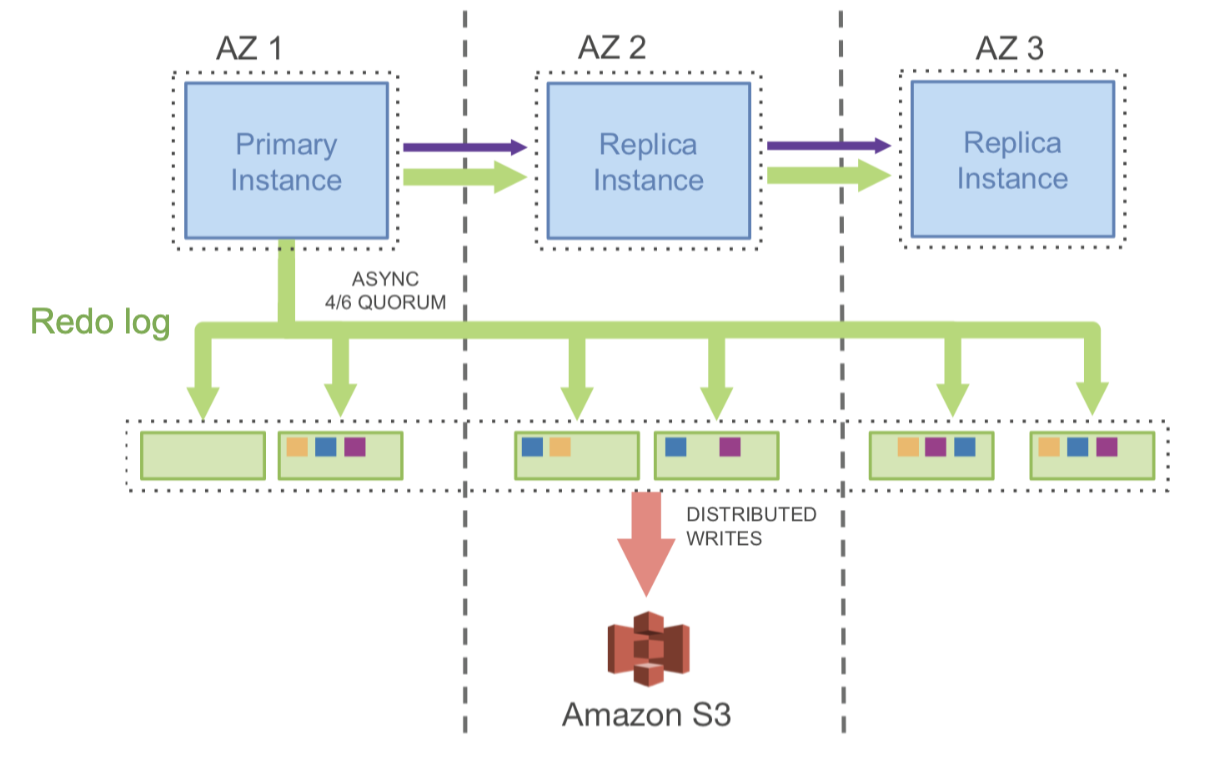
- Logging uses async quorum: wait until 4 of 6 nodes reply (faster than waiting for all 6)
- Each storage node takes the log and rebuilds theDB pages locally
- Care taken to handle incomplete logs due to async quorums
- Other features
- Rapidly add or remove read replicas
- Serverless Aurora (onlypay when actively running queries)
- Efficient DB recovery, cloning and rollback (use a prefix of the log and older pages)
OLAP - BigQuery
- Goal - cloud OLAP
- Interface - SQL, JDBC, ODBC, etc
- Consistency - depends on storage chosen (object stores or richer table storage)
- Traditional data warehouses - no elasticity
- BigQuery and other elastic analytics systems
- Separate compute and storage
- Users pay separately for storage & queries
- Get performance of 1000s of servers to run a query, but only pay for a few seconds of use
- Results
- These elastic services generally provide better performance and cost for ad-hoc small queries than launching a cluster
- For big organizations or long queries, paying per query can be challenging, so these services let you bound total # of nodes
- Interesting challenges
- User-defined functions (UDFs) - need to isolate across tenants (e.g. in separate VMs)
- Scheduling - How to quickly launch a query on many nodes and combine results? How to isolate users from each other?
- Indexing - BigQuery tries to mostly do scans over column-oriented files
ACID over object stores - Delta Lake (Databricks)
- Motivation - Object stores are the largest, most cost effective storage systems, but their semantics make it hard to manage mutable datasets
- Goal - analytical table storage over object stores, built as a client library (no other services)
- Interface - relational tables with SQL queries
- Consistency - serializable ACID transactions
- Problems with naive “Just Objects”
- No multi-object transactions
- Hard to insert multiple objects at once(what if your load job crashes partway through?)
- Hard to update multiple objects at once(e.g. delete a user or fix their records)
- Hard to change data layout & partitioning
- Poor performance
- LIST is expensive (only 1000 results/request!)
- Can’t do streaming inserts (too many small files)
- Expensive to load metadata (e.g. column stats)
- No multi-object transactions
- Delta Lake's implementation
- Can we implement a transaction log on top of the object store to retain its scale & reliability but provide stronger semantics?
- Table = directory of data objects, with a set of log objects stored in _delta_log subdir
- Log specifies which data objects are part of the table at a given version
- One log object for each write transaction, in order: 000001.json, 000002.json, etc
- Periodic checkpoints of the log in Parquet format contain object list + column statistics
- Other features from this design
- Caching data & log objects on workers is safe because they are immutable
- Time travel - can query or restore an old version of the table while those objects are retained
- Background optimization - compact small writes or change data ordering (e.g. Z-order) without affecting concurrent readers
- Audit logging - who wrote to the table
- Other "bolt-on" (bolt-on causal consistency) systems
- Apache Hudi (at Uber) and Iceberg (at Netflix) also offer table storage on S3
- Google BigTable was built over GFS
- Filesystems that use S3 as a block store (e.g. early Hadoop s3:/, Goofys, MooseFS)
Conclusion
- Elasticity with separate compute & storage
- Very large scale
- Multi-tenancy - security, performance isolation
- Updating without regressions
1.1.10. Streaming Systems
Motivation - Many datasets arrive in real time, and we want to compute queries on them continuously (efficiently update result)
All five letters - Kafka, Storm, Flink, Spark
Streaming query semantics
Streams
Def - A stream is a sequence of tuples, each of which has a special processing_time attribute that indicates when it arrives at the system. New tuples in a stream have non-decreasing processing times.
- event_time (in reality, may be out-of-order), processing_time
Bounding event time skew
- Some systems allow setting a max delay on late records to avoid keeping an unbounded amount of state for event time queries
- Usually combined with “watermarks”: track event times currently being processed and set the threshold based on that
Stanford CQL (Continuous Query Language)
“SQL on streams” semantics based on SQL over relations + stream ⟷relation operators

Stream-to-Relation ops
- Windowing - select a contiguous range of a stream in processing time (by time, tuples, partitions)
- Many downstream operations could only be done on bounded windows!
Relation-to-Relation ops - normal SQL
Relation-to-Stream ops
- Capture changes in a relation (each relation has a different version at each process time t)
ISTREAM(R),DSTREAM(R)contains a tuple (s, t) when tuple s was inserted/deleted in R at proc. time t.RSTREAM(R)contain (s, t) for every tuple in R at proc. time time t
Examples
SELECT ISTREAM(*) FROM visits [RANGE UNBOUNDED] WHERE page=“checkout.html”- Returns a stream of all visits to checkout
- convert visits stream to a relation via “[RANGE UNBOUNDED]” window
- Selection on this relation (σpage=checkout)
- convert the resulting relation to an ISTREAM (just output new items)
Syntactic Sugar in CQL - automatically infer “range unbounded” and “istream” for queries on streams
In CQL, every relation has a new version at each processing time
In CQL, the system updates all tables or output streams at each processing time (whenever an event or query arrives)
Google Dataflow model
- More recent API, used at Google and open sourced (API only) as Apache Beam
- Somewhat simpler approach - streams only, but can still output either streams or relations
- Many operators and features specifically for event time & windowing
- Model - Each operator has several properties
- Windowing - how to group input tuples (can be by processing time or event time)
- Trigger - when the operator should output data downstream
- Incremental processing mode - how to pass changing results downstream (e.g. retract an old result due to late data)
Spark Structured Streaming
- Even simpler model: specify an end-to-end SQL query, triggers, and output mode
- Spark will automatically incrementalize query
- Example Spark SQL batch query
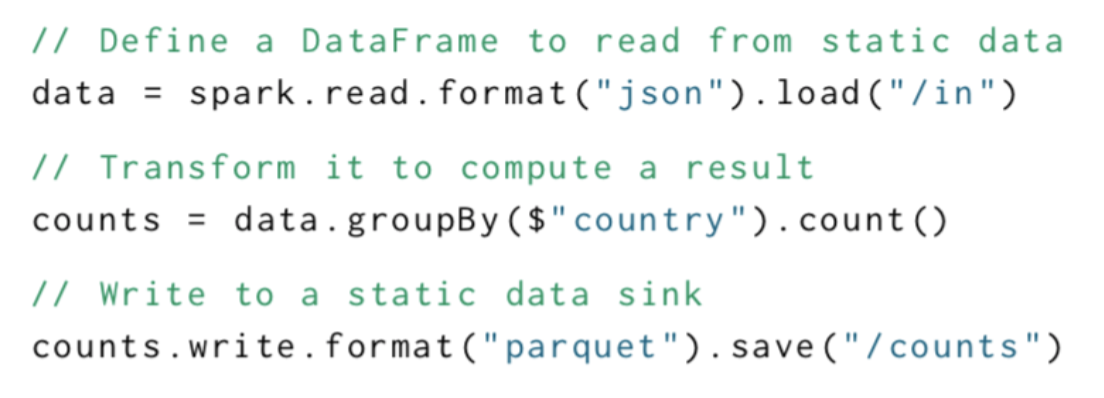
- Spark SQL streaming query
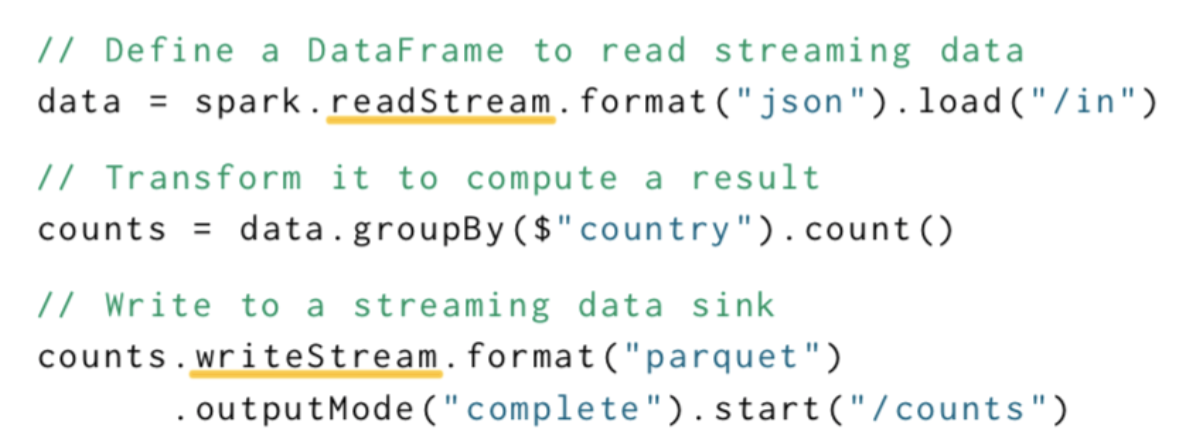
- Other streaming API features
- Session windows - each window is a user session (e.g. 2 events count as part of the same session if they are <30 mins apart)
- Custom stateful operators - let users write custom functions that maintain a “state” object for each key
Outputs to other systems
- Transaction approach - streaming system maintains some “last update time” field in the output transactionally with its writes
- At-least-once approach - for queries that only insert data (maybe by key), just run again from last proc. time known to have succeeded
Query planning & execution
How to run streaming queries?
- Query planning - convert the streaming query to a set of physical operators - Usually done via rules
- Execute physical operators - Many of these are “stateful”: must remember data (e.g.counts) across tuples
- Maintain some state reliably for recovery - Can use a write-ahead log
Query planning - “incrementalize” a SQL query?
Fault tolerance
Need to maintain
- What data we outputted inexternal systems (usually, up to which processing time)
- What data we read from each source at each proc. time (can also ask sources to replay)
- State for operators, e.g. partial count & sum
What order should we log these items in?
- Typically must log what we read at each proc. time before we output for that proc. time
- Can log operator state asynchronously if we can replay our input streams
Example - structured streaming
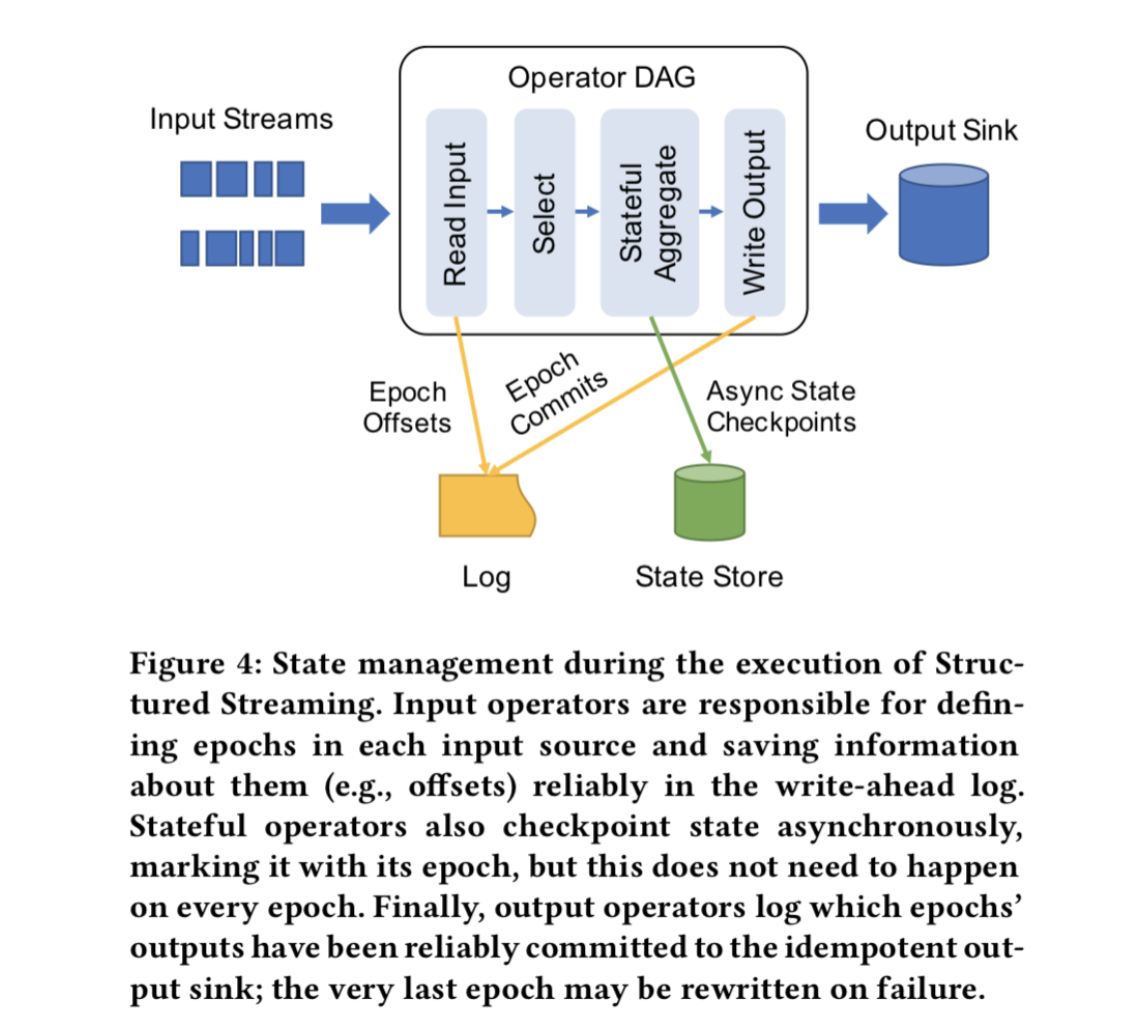
Parallel processing
- Required for very large streams, e.g. app logs or sensor data
- Additional complexity from a few factors (with typical implementation)
- How to recover quickly from faults & stragglers?
- Split up the recovery work (like MapReduce)
- How to log in parallel?
- Master node can log input offsets for all readers on each “epoch”
- state logged asynchronously
- How to write parallel output atomically?(An issue for parallel jobs in general; see Delta)
- Use transactions or only offer “at-least-once”
- How to recover quickly from faults & stragglers?
Summary
- Streaming apps require a different semantics
- They can be implemented using many of the techniques we saw before
- Rule-based planner to transform SQL ASTs into incremental query plans
- Standard relational optimizations & operators
- Write-ahead logging & transactions
1.1.11. Review
Typical system challenges
- Reliability - in the face of hardware crashes, bugs, bad user input, etc
- Concurrency: access by multiple users
- Performance: throughput, latency, etc
- Access interface: from many, changing apps
- Security and data privacy
Two big ideas: declarative interfaces & transactions
Key concepts
- Arch
- Traditional RDBMS:self-contained end to end system
- Data lake - separate storage from compute engines to let many engines use same data
- Hardware
- Latency, throughput, capacity
- Random vs sequential I/Os
- Caching & 5-minute rule
- Storage
- Field encoding
- Record encoding - fixed/variable format, etc.
- Table encoding - row/column oriented
- Data ordering
- Indexes - dense/sparse, B+-trees/hashing, multi-dimensional
- Query execution
- Query representation - e.g. SQL
- Logcial query plan - relational algebra
- Optimized logical plan
- Physical plan - code/operators to run
- Many execution methods - per-record exec, vectorization, compilation
- Relational algebra
- ∩, ⋃, –, ⨯, σ, P, ⨝, G
- Optimation
- Rule-based: systematically replace some expressions with other expressions
- Cost-based: propose several execution plans and pick best based on a cost model
- Adaptive: update execution plan at runtime
- Data statistics: can be computed or estimated cheaply to guide decisions
- Correctness
- Consistency constraints: generic way to define correctness with Boolean predicates
- Transaction: collection of actions that preserve consistency
- Transaction API: commit, abort, etc
- Recovery
- Failture models
- Undo, redo, undo/redo logging
- Recovery rules for various algorithms (including handling crashes during recovery)
- Checkpointing and its effect on recovery
- External actions → idempotence, 2PC
- Concurrency
- Isolation levels, especially serializability
- Testing for serializability: conflict serializability, precedence graphs
- Locking:lock modes, hierarchical locks, and lock schedules (well formed, legal, 2PL)
- Optimistic validation:rules and pros+cons
- Recoverable, ACR & strict schedules
- Isolation levels, especially serializability
- Distributed
- Partitioning and replication
- Consensus: nodes eventually agree on one value despite up to F failures
- 2-Phase commit: parties all agree to commit unless one aborts (no permanent failures)
- Parallel queries: comm cost, load balance, faults
- BASE and relaxing consistency
- Security & privacy
- Threat models
- Security goals: authentication, authorization, auditing, confidentiality, integrity etc.
- Differential privacy: definitions, computing sensitivity & stability
- Putting all together
- How can you integrate these different concepts into a coherent system design?
- How to change system to meet various goals (performance, concurrency, security, etc)?